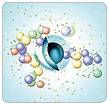 Scientific American has covered the latest advance with nanoparticles for brain tumors. Researchers at the University of Michigan have tested a drug delivery system that involves drug-toting nanoparticles and a guiding peptide to target cancerous cells in the brain.
Scientific American has covered the latest advance with nanoparticles for brain tumors. Researchers at the University of Michigan have tested a drug delivery system that involves drug-toting nanoparticles and a guiding peptide to target cancerous cells in the brain.This study finds that using the nanoparticles the drug can be delivered to a tumor's general vicinity [reported in Clinical Cancer Research]. The researchers used a pharmaceutical called Photofrin, which is photodynamic, meaning it is activated by a laser after it has entered the bloodstream. This new system, which uses intravenous delivery of 40-nanometer-wide particles to carry the drug, may actually avoid much of the unwanted photosensitivity, because less Photofrin circulates in the bloodstream.
It also avoided crossing the blood-brain barrier, which keeps many substances from entering the brain from the bloodstream.

